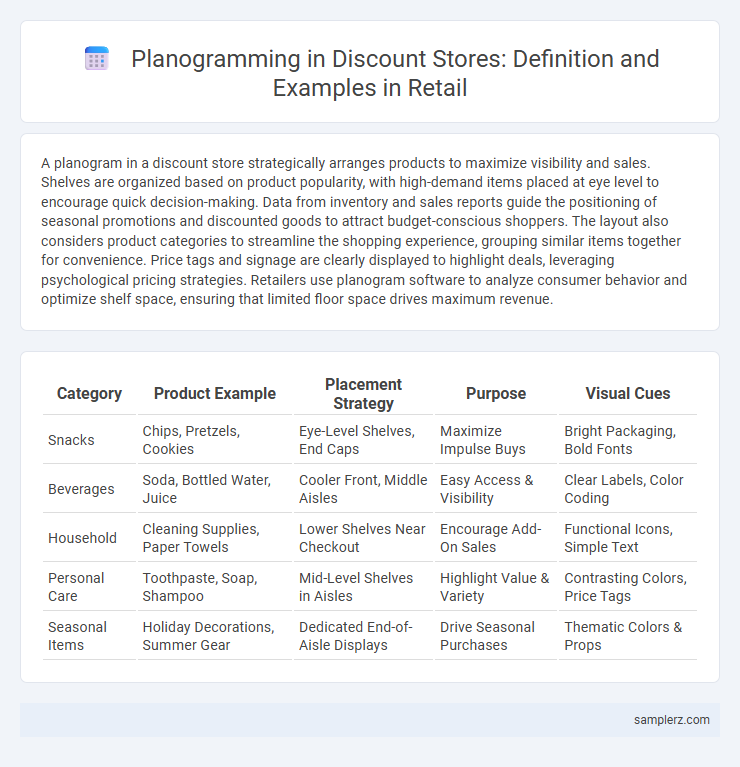A planogram in a discount store strategically arranges products to maximize visibility and sales. Shelves are organized based on product popularity, with high-demand items placed at eye level to encourage quick decision-making. Data from inventory and sales reports guide the positioning of seasonal promotions and discounted goods to attract budget-conscious shoppers. The layout also considers product categories to streamline the shopping experience, grouping similar items together for convenience. Price tags and signage are clearly displayed to highlight deals, leveraging psychological pricing strategies. Retailers use planogram software to analyze consumer behavior and optimize shelf space, ensuring that limited floor space drives maximum revenue.
Table of Comparison
| Category | Product Example | Placement Strategy | Purpose | Visual Cues |
|---|---|---|---|---|
| Snacks | Chips, Pretzels, Cookies | Eye-Level Shelves, End Caps | Maximize Impulse Buys | Bright Packaging, Bold Fonts |
| Beverages | Soda, Bottled Water, Juice | Cooler Front, Middle Aisles | Easy Access & Visibility | Clear Labels, Color Coding |
| Household | Cleaning Supplies, Paper Towels | Lower Shelves Near Checkout | Encourage Add-On Sales | Functional Icons, Simple Text |
| Personal Care | Toothpaste, Soap, Shampoo | Mid-Level Shelves in Aisles | Highlight Value & Variety | Contrasting Colors, Price Tags |
| Seasonal Items | Holiday Decorations, Summer Gear | Dedicated End-of-Aisle Displays | Drive Seasonal Purchases | Thematic Colors & Props |
Introduction to Planogramming in Discount Stores
Planogramming in discount stores organizes product displays to maximize shelf space, enhance product visibility, and improve shopper navigation. By strategically placing high-demand items at eye level and grouping similar products, these stores increase sales and optimize inventory management. Effective planogram design also supports promotional campaigns and ensures compliance with brand standards, driving consistent customer experiences.
Importance of Planograms for Retail Efficiency
Planograms in discount stores optimize shelf space by strategically placing high-demand and complementary products, driving increased sales and reducing inventory waste. Clear visual guidelines from planograms enhance stocking efficiency, minimize restocking errors, and ensure consistent product availability across all store locations. This structured approach supports better consumer navigation, encourages impulsive purchases, and ultimately boosts overall retail performance and profitability.
Key Elements of an Effective Discount Store Planogram
An effective discount store planogram strategically places high-demand, low-cost items at eye level to maximize consumer visibility and drive impulse purchases. It integrates clear signage and consistent product categorization to streamline shopping experiences and enhance inventory management efficiency. Shelf space allocation prioritizes fast-moving products while maintaining adequate exposure for promotional and seasonal items to boost sales velocity.
Product Placement Strategies for High Turnover Items
Strategic product placement in discount stores centers on positioning high turnover items at eye level and near store entrances to maximize visibility and drive impulse purchases. Grouping complementary products together enhances shopper convenience and increases average basket size, while endcap displays highlight promotional or seasonal goods, optimizing space and boosting sales velocity. Utilizing planogram software ensures consistent shelf layouts, which streamlines restocking and maintains optimal product exposure to sustain rapid inventory movement.
Seasonal and Promotional Merchandise Organization
Seasonal and promotional merchandise organization in discount stores relies on strategic planogramming to maximize visibility and drive sales during peak periods. Products are grouped by theme, such as holiday decor or back-to-school supplies, enabling efficient shopping experiences and targeted marketing. High-traffic aisles and end caps are prioritized for these displays to capitalize on impulse purchases and limited-time offers.
Maximizing Space Utilization on Limited Store Shelves
Planogramming in discount stores strategically arranges products to maximize space utilization on limited store shelves, ensuring high-demand items receive prime shelf placement to boost sales. By using vertical shelving, wire racks, and adjustable fixtures, stores efficiently display a wider variety of products without overcrowding. Data-driven insights guide the placement of best-selling products at eye level, enhancing visibility and encouraging impulse purchases.
Visual Merchandising Examples in Discount Stores
In discount stores, planogramming strategically places high-demand and impulse-buy items at eye level to maximize visibility and increase sales. Bulk-packaged products are arranged on lower shelves to emphasize value, while seasonal promotions use end caps and brightly colored signage to attract shopper attention. Clear aisle layouts and consistent product groupings enhance navigation, supporting efficient shopping experiences and higher turnover rates.
Case Study: Planogram for Household Goods Section
The planogram for the household goods section in a discount store strategically arranges essential items like cleaning supplies, kitchenware, and storage solutions to maximize visibility and accessibility. High-demand products such as multi-purpose cleaners and affordable cookware are placed at eye level to drive impulse purchases while bulkier items like buckets and mop sets occupy lower shelves to optimize shelf space. Sales data analysis and customer flow patterns guide the layout, resulting in increased turnover and improved inventory management for household goods.
Technology Tools for Planogramming in Discount Retail
Technology tools for planogramming in discount retail often include specialized software such as Blue Yonder and Nielsen Spaceman, which enable optimized shelf layouts by analyzing sales data and customer behavior. These tools use AI-driven simulations to improve product placement, maximize shelf space utilization, and increase overall store profitability. Integration with inventory management systems ensures real-time updates and consistency across multiple store locations, streamlining operations and enhancing the shopping experience.
Measuring Success: Analyzing Planogram Performance
Analyzing planogram performance in discount stores involves tracking sales data, product placement effectiveness, and customer flow patterns to measure success accurately. Key performance indicators such as increased product visibility, improved sales per square foot, and reduced out-of-stock incidents provide actionable insights. Utilizing heatmaps and transaction analytics helps optimize shelf layouts, ensuring the planogram drives higher revenue and enhances shopper experience.

example of planogramming in discount store Infographic
 samplerz.com
samplerz.com